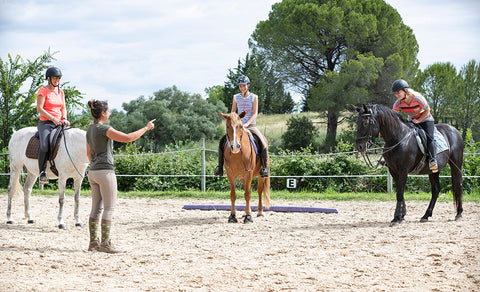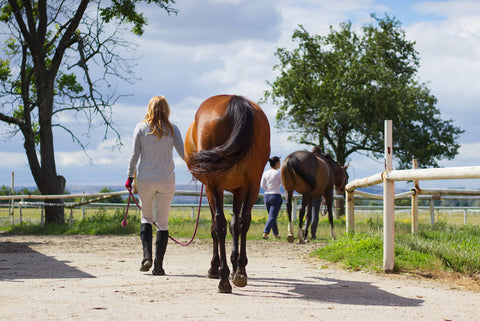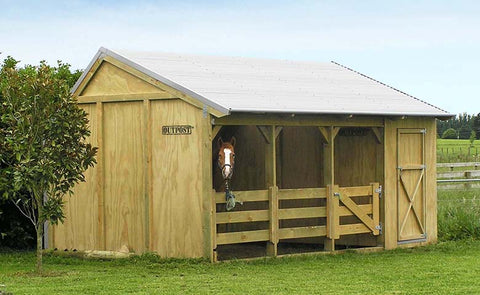Have you ever considered horse riding as an extreme sport? There is significant risk involved when we work with these beautiful, powerful animals, especially if we are not familiar with their temperament or in tune with their needs.
Horse safety is integral to building trust with your equine, eliminating risk and ensuring a long and healthy relationship when handling, grooming and riding.
The first thing you should do to keep your horse safe is make sure you have safe and secure fencing that prevents your horse from getting out onto roads or anywhere that they might get hurt.
In the wild, horses would bolt at the first notion of danger, this is key to their survival. This fight or flight instinct is carried over into domesticated animals in similar ways just like it is with humans. Even if you and your horse have worked together for many years and secured a trusting bond, one wrong move that startles your horse could wind you up in a bad shape.

Equestrian Safety
What are the safety procedures a horse handler should follow when working around horses?
When hanging out with, working with and riding our horses, we need to learn and implement basic safety techniques. This doesn’t only reduce the possibility of accidents happening, it also encourages trust between a horse and their human.
Approaching
- Always speak to your horse before approaching or touching them to avoid startling them. This way they know where you’re coming from and who you are.
- Always approach your horse from the side where they can see you. If they are facing away from you, you can call out or entice them with a treat. If they’re in a stall and this is not possible, try to approach them from an angle. Never approach from behind.
- When you pet a horse, place your hand on their shoulder or neck first and create a firm but gentle stroking action. Don’t go straight for the nose.
- Encourage them to face you and notice their expression before approaching.
- Take caution when entering a pasture or paddock with multiple horses.
- Avoid bringing food into a herd as this will cause them to crowd and compete for the food.
Handling
- Always wear boots or hard toed shoes when you’re working around your horse. If they step in your direction you will not want to feel the force of their hooves on your toes!
- Use a quick release knot or have someone hold your horse with a lead rope while you work around them.
- Work as close to the shoulder of your horse as possible. This protects you from being kicked.
- Let your horse know your intentions. If you intend to lift the foot, run your hand from their shoulder down to the leg. When you reach the fetlock, say “up” and squeeze the joint. This should encourage your horse to pick up their feet for you.
- Never stand directly behind or in front of your horse. The positioning of their eyes means they have a blind spot in front. Stand slightly to either side for any kind of interaction so they can see you clearly.
- Your temperament will affect your horse's temperament. If you stay calm and competent, so will they.
Leading
- When leading your horse, walk beside them about level with their head or between their head and shoulder. Do not walk ahead or behind your horse.
- Attach a lead rope to the halter, do not use the halter itself. You won’t have any options if the horse were to startle.
- Use a long lead shank and use both hands while leading.
- Fold the lead rope back and forth and grasp the middle of the folds, instead of looping it around your hands - this way it won’t tighten when pulled.
- Never wrap the lead rope or other lines attached to the horse around any part of your body.
- It's customary to lead from the left side of the horse where your right hand will hold the lead close to the halter.
- Extend your right elbow slightly towards the horse, it will be the first point of contact should the horse strike out.
- Avoid using excessively long lead ropes to prevent entanglement.
- When turning a horse loose, lead them fully through the doorway and turn the horse around to face the entry. Only then, release the shank, remove the halter or bridle.
Tying
- When tying, the knot should be at least as high as the horse's eye.
- The distance from the knot to the halter should be no longer than the length of your arm.
- Use a quick release knot or breakaway string to tie your horse to a solid and safe object.
- Remember to keep your fingers out of the loops as you tie the knot.
- Tie only with a halter and lead and never with bridle reins.
Grooming
- Don’t stand directly in front or behind your horse when grooming their head, brushing or braiding their tail.
- If you need to walk behind your horses there are two things you can do to avoid kicking incidents:
- Stay close enough that you can brush against them, this way, the force from a kick won’t have much power.
- Stay far enough away from them as you move around to be out of kicking range.
- Avoid having to duck under the tie rope to move around. You’ll be in a vulnerable position If your horse pulls back on you.
- Never kneel or sit on the ground when working on your horse. Stay in a squatting position so you can quickly jump away in case he startles.
- Be careful not to drop your grooming tools anywhere you may trip or the horse may step on them.
Attitude
- Don’t tease your horse. This can lead to them developing bad habits.
- When feeding treats, hold your hand out flat to avoid any nipping.
- If you can, put treats in a bucket before you offer them to your horse.
- Avoid feeding your horse treats from your hand regularly.
- If your horse disobeys and needs reprimanding, do it immediately. If you wait, they will not understand why they are being punished.
- Never use anger, aggression or physical force when disciplining.

How should a beginner handle a horse?
Learning the ropes when it comes to horse riding is a steep learning curve but the benefits can lead to a ton of adventure. It's important to put the work in to ensure safety with your horses at all times so these adventures can be taken risk free. Beginner riders and children should not mount or ride a horse without supervision.
If you don’t have any experience handling horses, you should definitely be guided by someone who does. Learn from what they do, don’t be afraid to ask questions and practice under their guidance. With some experience and plenty of time spent with the herd, horse handling will become second nature in no time.
What should you not do while riding a horse?
Although these pointers may come as second nature to experienced equestrians, those who have not spent a lot of time around horses should remember these basic safety rules while riding a horse.
- Unless your horse riding skills are well established, you should always ride with a professional or under supervision. Any jumping work should be supervised at all times.
- You should never ride without safety gear, including:
- Proper footwear - boots or shoes with hard toes and a heel to hook onto the stirrup.
- A helmet - one that meets safety standards.
- Safety or breakaway stirrups - these are designed to easily release the foot in an event of a fall.
- A safety vest - especially if you’re taking up cross-country jumping.

How do you keep a horse safe?
A safe and secure horse shelter
The best way to keep your horse safe is to treat your horse to the best shelter the market has to offer. Outpost buildings horse shelters are extremely strong and secure, designed with the comfort and safety of you and your horses in mind.
Outpost Buildings are made with sustainably sourced and New Zealand grown timber framing and they’re quieter and warmer than steel buildings. We have several different styles of horse shelter to choose from:
- Paddock shelters - These kitset buildings are designed to be placed alongside pastures and are great for giving your horses protection from the elements. They’re also relocatable, so you can move them wherever you want, even after construction.
- Shelter with tack room - For easy access to feed, saddles, and other equine equipment. A tack room attachment to a typical shelter provides protection for both your horses and your supplies.
- Hunter stables - Our hunter stables are some of the toughest and most durable horse shelters. They offer various sized lodgings for your horses: a great option for those who want plenty of room for their horses.
Other precautions you can take to keep your horses safe:
- Lock up everything at night. That can include any gates to your property and tack rooms.
- Keep important documents in a secure place, such as equine passports and ownership documents.
- Install security equipment. Even a motion sensor activated light will notify you of any unwanted movement.
- ID your horse. You can do this with microchipping or weaving an ID tag into their mane.
Additionally, the logistics of building a horse stable can be daunting, see our guide on How to build a horse stable for more insight.

What to do when a horse tries to walk in front of you when leading?
Humans' natural reactions tend to arise from our predator instinct, which may seem overbearing to a nervous animal such as your horse. However, your horse's natural reaction arises from their prey instinct, which would be to put as much space as possible between themselves and any danger. For this reason, you will want to calm your horse down in any situation where they may feel anxious.
If you find your horse walks ahead of you while you are leading, this is likely to do with their flight mode kicking in. To bring the control back patiently, you should stop moving and let your horse move around you. You don’t need to pull your horse or hold the lead too closely. Instead, put some distance between the two of you to let them know they have space. Let them walk around you to calm down.
Once your horse has calmed down and reinstates the trust between you, you can walk on. Repeat this pattern if they start to walk ahead again. You can also use treats to reward them once they stop.
Why would a horse kick another horse?
Horses kick to defend themselves. In the wild, horses can use powerful kicking motions to ward off predators. They have a lot of power in their back legs for this reason. If you find your horse kicking another horse, it may be in defence mode. Maybe the other horse is getting too close to its food or its foal or it is acting aggressive.
This may be why your horse also kicks when they are startled or someone walks up behind them. Kicking while being handled, ridden or driven can become a dangerous habit if not addressed appropriately.
Why does a horse rub its head on you?
There may be a few reasons to explain why horses like to rub their heads on their owners, or rub their heads on pretty much anything for that matter! First of all, in the wild, horses would mutually groom each other by standing side by side and mildly biting their mate to rid themselves of insects or debris. In this sense, your horse is either showing a sign of affection towards you or perhaps, wanting to be “mutually groomed”.
On another note, if your horse is itchy, you’ve probably noticed them scratching themselves on any object that’s nearby. Perhaps you are conveniently close by and can help them with a good scratch!
Whatever the reason for the head rub, this behaviour can actually be dangerous and should be discouraged. Horses are much stronger than humans, if they knock you over it might cause you injury or startle your horse. Additionally, if it becomes a habit, they may try the head rub on children and that could go badly.
If this happens, you can gently redirect their head away from you and give them a good scratch with your hands. Another idea is to install a scratch post and encourage them to use that instead.
For any additional questions, please feel free to contact the team here at Outpost Buildings.




